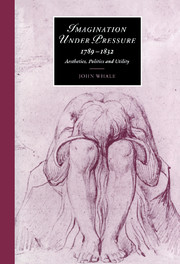Book contents
- Frontmatter
- Contents
- Acknowledgements
- Introduction
- Part I IMAGINATION AND REVOLUTION
- Part II IMAGINATION AND UTILITY
- 4 Hazlitt and the limits of the sympathetic imagination
- 5 Cobbett's imaginary landscape
- 6 Coleridge and the afterlife of imagination
- Afterword
- Notes
- Bibliography
- Index
- CAMBRIDGE STUDIES IN ROMANTICISM
4 - Hazlitt and the limits of the sympathetic imagination
Published online by Cambridge University Press: 22 September 2009
- Frontmatter
- Contents
- Acknowledgements
- Introduction
- Part I IMAGINATION AND REVOLUTION
- Part II IMAGINATION AND UTILITY
- 4 Hazlitt and the limits of the sympathetic imagination
- 5 Cobbett's imaginary landscape
- 6 Coleridge and the afterlife of imagination
- Afterword
- Notes
- Bibliography
- Index
- CAMBRIDGE STUDIES IN ROMANTICISM
Summary
Hazlitt's aesthetics are caught between sympathy and power, the learned and the vulgar, the body and ideas. His voluminous journalistic output in the first three decades of the nineteenth century characteristically defies system or theory, even though it contains clearly discernible preoccupations and consistent modes of thought. Throughout his career Hazlitt is concerned with the capacity of sympathy to enable individuals to rise above mere selfishness and to enter a community of feeling. This is the substance of his first published and most systematic work On the Principles of Human Action (1805) and of one of his last articles, ‘On Benevolence and Self-Love’, published in the New Monthly Magazine in 1828. His aesthetics might thus be roughly described as celebrating the power of the sympathetic imagination. But Hazlitt's writing resists such an oversimplification, not least because such an overview belies the conflicts and contradictions within his kind of oppositional writing, and also because the word ‘celebration’ denies the unease which haunts his sense of the aesthetic.
Hazlitt's writings represent a conscientious attempt to test the efficacy of the sympathetic imagination against the negative effects of the dominant ideology. In this chapter I have chosen to represent this career-long examination by focusing on his complex responses to Burke and Coleridge and on his collections of essays from 1818 to 1826, rather than the early Essay on the Principles of Human Action, his famous art criticism, or his infamous Liber Amoris – all of which contribute significantly to this issue.
- Type
- Chapter
- Information
- Imagination under Pressure, 1789–1832Aesthetics, Politics and Utility, pp. 110 - 139Publisher: Cambridge University PressPrint publication year: 2000
- 2
- Cited by



